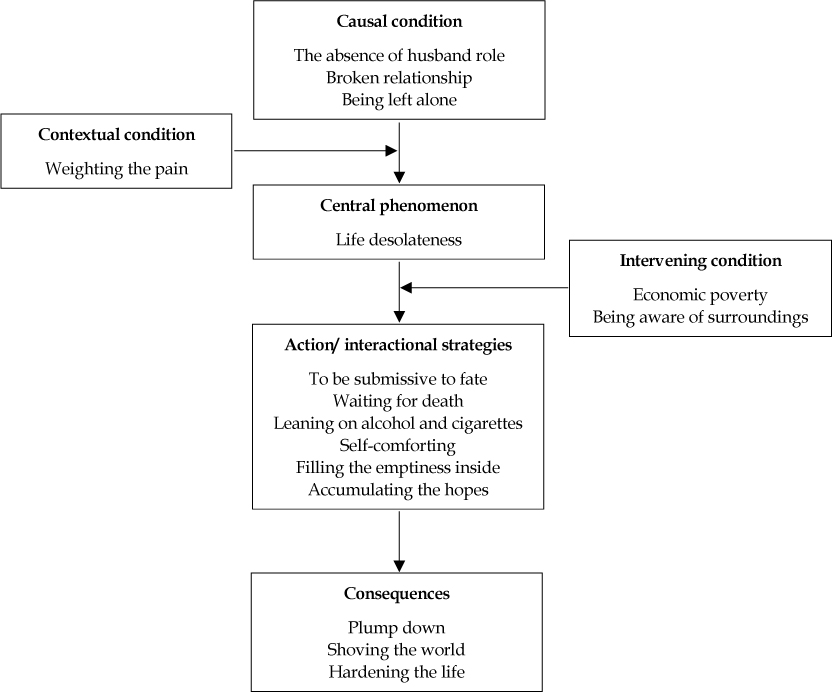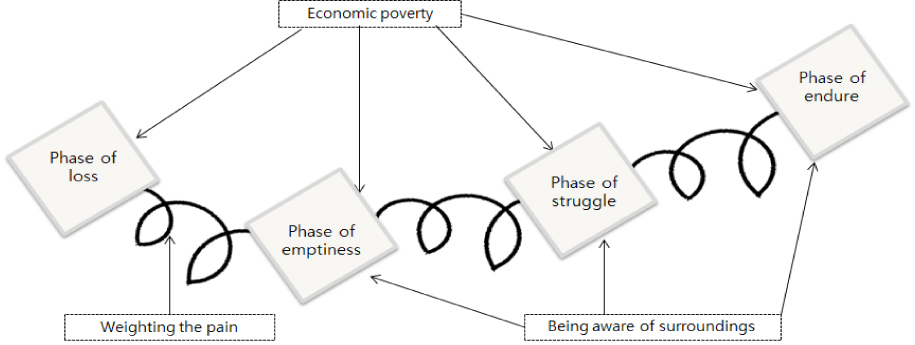J Korean Acad Psychiatr Ment Health Nurs.
2016 Sep;25(3):195-206. 10.12934/jkpmhn.2016.25.3.195.
A Study on the Experience of Depression in Elderly Women Living Alone
- Affiliations
-
- 1Department of Nursing, Daewon University, Jecheon.
- 2College of Nursing, Ewha Womans University, Seoul, Korea. happysgmr@mail.daewon.ac.kr
- KMID: 2354866
- DOI: http://doi.org/10.12934/jkpmhn.2016.25.3.195
Abstract
- PURPOSE
This study was done to explore the experience process for depression in elderly women living alone.
METHODS
Data was analyzed using Strauss and Corbin's Grounded theory. The twelve participants were elderly women living alone, aged 65 to 80 years.
RESULTS
From the participants' statements, 116 concepts, 43 sub-categories and 16 categories were extracted by an open coding process. Core category was 'wandering in a waste land'. The experience process leading to depression in elderly women living alone had 4 phases: loss, emptiness, struggle and response.
CONCLUSION
The findings in this study on the experience of depression in elderly women living alone can be used for evidence in a detailed assessment, early detection and prevention of depression in elderly women living alone.
Keyword
Figure
Reference
-
1. Statistics Korea. 2015 Statistics on the aged in Korea [Internet]. 2015. cited 2016 July 7. Available from: http://kostat.go.kr/portal/korea/kor_nw/2/6/1/index.-board?bmode=read&bSeq=&aSeq=348565&pageNo=1&row-Num=10&navCount=10&currPg=&sTarget=title&sTxt=.2. Korea Institute for Health and Social Affairs. Survey of the Elderly 2014. Policy Research Report. Ministry of Health & Welfare;2014. 12. Report No. 2014-61.3. Kornstein SG, Schatzberg AF, Thase ME, Yonkers KA, McCullough JP, Keitner GI, et al. Gender differences in chronic major and double depression. J Affect Disord. 2000; 60(1):1–11. DOI: 10.1016/s0165-0327(99)00158-5.
Article4. Comprehensive Support Center for the Elderly Living Alone. Analysis about elderly living alone survey analysis and challenge to build a safety net. Policy Research Report. Ministry of Health & Welfare;2014. 12. Report No. 2014-06.5. Hong SJ. Gerontology. 2nd ed. Seoul: Hawoo;2010. p. 50–52.6. Park JE, Kim BS, Bae JN, Kim KW, Seong SJ, Cho MJ. Depressive symptomatology among the living-alone elderly: hopelessness and boredom. J Korean Geriatr Psychiatry. 2012; 16(2):97–103.7. Sohn JN. Factors Influencing depressive symptoms in community dwelling older People. J Korean Acad Psychiatr Ment Health Nurs. 2013; 22(2):107–116. DOI: 10.12934/jkpmhn.2013.22.2.107.
Article8. Won MR, Choi YJ. Are Koreans prepared for the rapid increase of the single-household elderly? life satisfaction and depression of the single-household elderly in Korea. ScientificWorldJournal. 2013; 1–4. DOI: 10.1155/2013/972194.
Article9. Lyness JM, Yu Q, Tang W, Tu X, Conwell Y. Risks for depression onset in primary care elderly patients: potential targets for preventive interventions. Am J Psychiatry. 166; 12:1375–1383. DOI: 10.1176/appi.ajp.2009.08101489.
Article10. Sohn JN. A study on factors influencing the suicidal ideation in elderly people who live alone or live with family. J Korean Acad Psychiatr Ment Health Nurs. 2012; 21(2):118–126. DOI: 10.12934/jkpmhn.2012.21.2.118.
Article11. Choi YJ, Won MR. Effects of tailored case management using a gatekeeper for the depressed single-household elderly population -focusing on the mental health case management-. J Korean Acad Community Health Nurs. 2012; 23(4):376–385. DOI: 10.12799/jkachn.2012.23.4.376.
Article12. Hooyman N, Kiyak H. Social gerontology: a multidisciplinary perspective. 9th ed. Boston: Ally & Bacon;p. 117–176.13. Lin PC, Wang HH. Factors associated with depressive symptoms among older adults living alone: an analysis of sex difference. Aging Ment Health. 2011; 15(8):1038–1044. DOI: 10.1080/13607863.2011.583623.
Article14. Chan A, Malhotra C, Malhotra R, Ostbye T. Living arrangements, social networks and depressive symptoms among older men and women in Singapore. Int J Geriatr Psychiatry. 2011; 26:630–639. DOI: 10.1002/gps.2574.
Article15. Park KN. Lives of elderly women living alone through their life histories. Issues Fem. 2004; 4:149–194.16. Ahn GD. A life history study on aged women living alone who receive the national basic livelihood security program. J Korean Gerontol Soc. 2012; 32(2):447–465.17. Kim C, Ko MH, Kim MJ, Kim JH, Kim HJ, Moon JH, et al. The life elderly women living alone. J Korean Acad Nurs. 2008; 38(5):739–747. DOI: 10.4040/jkan.2008.38.5.739.18. Corbin J, Strauss A. Basics of qualitative research: techniques and procedures for developing grounded theory. 3rd ed. Newbury Park, CA: Sage;2008. p. 143–312.19. Cho MJ, Bae JN, Suh GH, Hahm BJ, Kim JK, Lee DW, et al. Validation of Geriatric Depression Scale, Korean Version (GDS) in the Assessment of DSM-III-R Major Depression. J Korean Neuropsychiatr Assoc. 1999; 38(1):48–63.20. Sandelowski M. The problem of rigor in qualitative research. ANS Adv Nurs Sci. 1986; 8(3):27–37. DOI: 10.1097/00012272-198604000-00005.
Article21. Korea Institute for Health and Social Affairs. Policy implications of changes in family structure: focused on the increase of single person households in Korea. Ministry of Health & Welfare;2012. 12. Report No. 20112-47-25.22. Kim HW. Thanks for visiting the elderly like me. Seoul: Oh my Book;2011. p. 51–54.23. Choe SJ, Kim UC, Kim GB. Maum as the basis of trust and distrust in interpersonal relationships from indigenous and cultural perspectives. Korean J Psychol Soc Issues. 2003; 9(2):1–17.24. Lee EK. A literary study of death and old age-focused on Kim Tae-soo' drama. J Drama. 2012; 36(14):133–161.25. Park MJ. The study of daily life of aged women living alone who receive the national basic livelihood security program. Health Soc Welf Rev. 2010; 30(1):62–91.
Article
- Full Text Links
- Actions
-
Cited
- CITED
-
- Close
- Share
- Similar articles
-
- Dietary Behaviors and Seasonal Diversity of Food Intakes of Elderly Women Living Alone as Compared to Those Living with Family in Gyeongbuk Rural Area
- A Study on the Perceived Health Status, Depression, and Activities of Daily Living for the Elderly in Urban Areas
- A Comparative Study on Health Status, Depression, and Quality of Life between the Elderly Living with Family and the Elderly Living Alone
- Factors Affecting Depression in Elderly Vulnerable People Living Alone
- The Effect of Depression on the Use of Medical Service: Focusing on Patients with Chronic Physical Illness among Middle-Aged and Elderly Women



